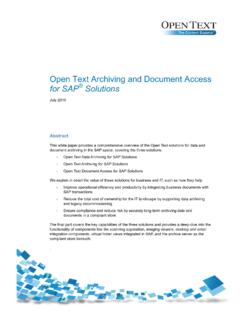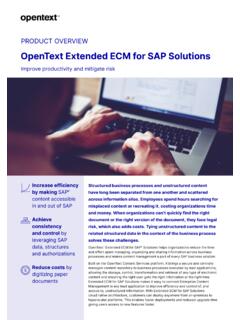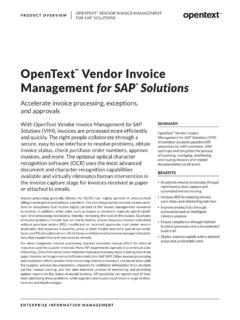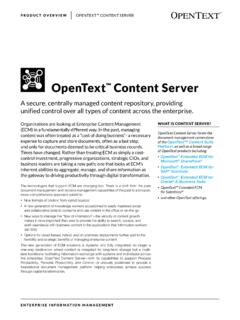Transcription of EDI Basics - OpenText
1 How Successful Businesses Connect, Communicate, and Collaborate Around the WorldEDI BasicsBUSINESS NETWORK2 EDI BASICSE-BOOKT able of ContentsForeword ..3 What is EDI? ..4 The EDI Process ..7 Sending EDI Documents ..8 Receiving EDI Documents ..9 Summary ..11 The Benefits of EDI ..12 EDI Milestones ..14 What are EDI Documents and Standards? ..15 EDI Standards ..16 Common Business Documents ..18 What Are Your Communications Options? ..20 Direct Connection Model ..21 Network Model .. 22 Direct or Network Which is Better? ..23 Most Commonly Used Communications Protocols ..23 Which Business Processes Typically Benefit From EDI? ..26 Procurement ..27 Shipping and Receiving ..28 Invoicing and Payments ..30 What Does an EDI Document Look Like? ..32 Segments ..34 Envelopes ..36 How Does a Company Implement an EDI Program?
2 37Do-It-Yourself Model ..38B2B Managed Services Model ..41 Conclusion ..42 Next Steps ..43 Connect With Us ..43 About OpenText ..43 BUSINESS NETWORK3 EDI BASICSE-BOOKF orewordBill Clinton once observed, The price of doing the same old thing is far higher than the price of change . Companies that are slow to adapt new technology to their business processes may find themselves consigned to the proverbial dustbin of history .Businesses have invested in technology such as Enterprise Resource Planning (ERP) systems to automate internal business processes, including accounts payable and receivable, inventory control, and intra-company communication . However, many of these same companies are slow to automate their business-to-business transactions, such as the exchange of purchase orders, invoices, and bills of lading.
3 Electronic commerce (e-commerce) is the exchange of information via electronic media, such as the internet and private communications networks . There are two types of e-commerce: Business-to-Business (B2B) and Business-to-Consumer (B2C) . Almost every day, each of us experiences B2C e-commerce, such as when we book airline tickets or hotel reservations online and then receive an electronic confirmation . This book focuses on electronic data interchange (EDI), the most commonly used B2B ecommerce technology .In today s business environment, EDI remains a gamechanger across all industries, including retail, banking, manufacturing, high-tech, and services . For many companies, it has become the lifeblood of their business, making them more efficient, driving down costs, and increasing customer satisfaction . It is the means by which they can differentiate themselves from their competition.
4 Using EDI, a manufacturer in Detroit, Michigan can send a purchase order to its supplier in Japan, receive an electronic document indicating that the item is out of stock, and immediately react by sending the purchase order to an alternative supplier in Brazil all in just minutes . This high level of visibility that is enabled by the use of EDI is critical to business success .EDI Basics introduces you to this electronic way of doing business so that you can participate knowledgeably in the conversation at your company about moving away from the old, manual processes .The pages that follow answer the questions: What is EDI? How does it work? What does it take for your company to get started?More than 85% of all electronic business transactions take place using EDI. This method of exchanging documents is used in industries including retail, banking, high-tech, manufacturing, and services.
5 What is EDI?In this chapter, you will learn: The definition of EDI How the EDI process works for sending and receiving documents The benefits of EDIBUSINESS NETWORK5 EDI BASICSE-BOOKIn today s business environment, B2B integration is a key to success; in fact, many companies will no longer do business with you if you can t do business electronically .While many businesses have incorporated emails and faxes into their B2B communication, these processes still involve human handling and are thus slow and prone to error . Although they provide improvements over postal mail-based processes, they lack the power and functionality of e-commerce . Figure 1 shows a simplified scenario in which a buyer faxes or mails an order to a supplier, who then faxes or mails an invoice back to the buyer .As you can see, this manual process involves a lot of paper, people, and time.
6 Mail can be slow and paper documents can be misplaced or lost . Once received, mailed and faxed documents must be manually entered into a computer application, a process that frequently results in errors . And even though an email is sent electronically, it too must be entered manually, because the computer application has no way of knowing where each piece of data needed is located within the email . Having people involved slows down the processing of the documents and also introduces errors .Figure 1: Manual Document ExchangeBUYER GENERATES PURCHASE ORDERSUPPLIER ENTERS ORDER INTO INTERNAL SYSTEMS AND PRINTS AN INVOICEBUYER ENTERS INVOICE INTO INTERNAL SYSTEM FOR PROCESSING INVOICEF axes or MailsFaxes or MailsElectronic communication has changed the way companies conduct business with each other . Business-to-business (B2B) electronic commerce (e-commerce), which includes EDI, XML (Extensible Markup Language), and online catalogues, has enabled the integration of companies throughout the world into communities of business partners (often called trading partners) with benefits for all.
7 BUSINESS NETWORK6 EDI BASICSE-BOOK In the 1960s, the railroad industry, which needed to find a faster and more efficient way to communicate information about goods being transported, began to send this data electronically . Other businesses realized the value of electronically exchanging information and so, beginning in the 1980s, many industries adopted EDI, the electronic exchange of standard-formatted business documents between computers . At first, only those businesses that could afford large mainframe computers were able to participate . But with the advent of the personal computer and then the availability of the internet, use of EDI became available to all companies regardless of size . Electronic Data Interchange (EDI) is the computer-to-computer exchange of business documents, such as purchase orders and invoices, in a standard electronic format between business partners, such as retailers and their suppliers, banks and their corporate clients, or car-makers and their parts suppliers.
8 The most common documents exchanged via EDI are purchase orders, invoices, and advance ship notices . But there are many others, such as bills of lading, customs documents, inventory documents, shipping-status documents, and payment documents .Because EDI documents are processed by computers, the computer s program must know where to find each piece of information in the incoming document and the format of that data . For example, are the numbers included in the data integer (e .g ., 12) or decimal (e .g ., 12 .0)? Are the dates in the form mmddyy or mmddyyyy? Just as two speakers of different languages cannot hold a conversation, two business systems, each with its own proprietary format rather than a common format, cannot exchange data with each other . Thus, a common, standard format is the language by which businesses communicate with each other via their computers.
9 EDI standards have been developed by organizations of concerned businesses to identify needs, create plans to meet those needs, and come to an agreement on the proposed standards . Subcommittees continually meet to propose new standards or changes in response to evolving business requirements . There are several EDI standards in use today . The most common cross-industry standards are ANSI, primarily used in the United States, and EDIFACT, primarily used in Europe and Asia . In addition, there are standards for specific industries, such as SWIFT for banking and RosettaNet for high-tech .Let s now look at how the EDI process works .Electronic Data Interchange (EDI) is the computer-to-computer exchange of business documents, such as purchase orders and invoices, in a standard electronic format between business partners. BUSINESS NETWORK7 EDI BASICSE-BOOKThe EDI ProcessToday, all types of business documents for industries such as retail, automotive, high tech, logistics, and banking can be exchanged using EDI.
10 These documents can flow from the sender s computer straight through to the appropriate application on the receiver s computer (e .g ., the order management system), where processing can begin immediately .With a fully integrated EDI system, the process can look like this no paper, no people, and almost no time .BUYER SINTERNAL SYSTEMP urchase OrderInvoiceSUPPLIER SINTERNAL SYSTEMF igure 2: EDI document exchangeAs you can see, sending and receiving EDI documents can be a seamless and efficient way to conduct standards provide a common data format, enabling computers to communicate. There are several EDI standards in use today along with standards for specific NETWORK8 EDI BASICSE-BOOKSENDING COMPANYDATA I NINTERNAL FORMATD irectEDI NetworkService ProviderRECEIVING COMPANYEDI TRANSLATOREDI DOCUMENTDATA I NINTERNAL FORMATEDI TRANSLATOREDI DOCUMENTS ending EDI DocumentsTo send an EDI document, you need to identify the data, create an EDI document, and transmit it.









